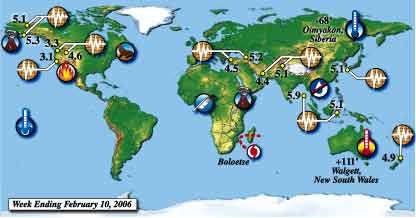La Nina Returns
Researchers from the U.S. National Oceanic and Atmospheric
Administration Climate Prediction Center announced that the
ocean-cooling phenomenon known as La Ni
ña developed across the tropical Pacific during the past two
months.
By Steve Newman
La Nina Returns
Researchers from the U.S. National Oceanic and Atmospheric Administration Climate Prediction Center announced that the ocean-cooling phenomenon known as La Niña developed across the tropical Pacific during the past two months. The reverse phase of the better-known El Niño ocean warming spread to cover a wide area between Indonesia and the coast of South America during the period. The researchers told a meteorological gathering in Atlanta that it’s too early to tell how the cooler Pacific surface waters will affect spring and summer weather in the Northern Hemisphere. But they said La Niña often coincides with stronger and more numerous hurricanes, wet weather in the Pacific Northwest and dry conditions in the southern United States.
Indian Ocean Cyclone
Tropical Cyclone Boloetse skirted Madagascar’s southern coast with category 2 winds as the storm churned the Indian Ocean basin for a third week. No reports of significant damage were received. Boloetse then weakened rapidly as it encountered the colder waters south of the island nation.
Wildfires
A poorly extinguished controlled burn in metropolitan Los Angeles erupted into a firestorm that forced 1,000 people from their homes when hot desert winds surged through the area. More than 1,000 firefighters battled the blazes near Anaheim, which blackened more than 7,000 acres. Those forced to evacuate were allowed to return home when the high winds shifted direction.
Eruptions
A volcano on an uninhabited island in Alaska’s Aleutian chain erupted with a cloud of ash that soared 22,000 feet into the sky about 175 miles southwest of Anchorage. The Alaska Volcano Observatory issued a Code Red warning, the highest level of alert, for Cleveland Volcano because the ash cloud reached a flight level where it could interfere with jet traffic.
Further eruptions of Ethiopia’s Erta Ale Volcano were observed by orbiting satellites. An eruption in September 2005 displaced about 40,000 nomads.
Bird Flu Reaches Africa
An outbreak of H5N1 avian influenza was discovered among poultry at a farm in northern Nigeria, marking the first time that strain of the virus has been detected in Africa. The World Health Organization said the outbreak occurred on a commercial chicken farm in the state of Kaduna. Despite measures by authorities to contain the outbreak, new cases were reported in other farms as far as 125 miles away by late in the week.
Vietnam Drought
A severe drought affecting northern Vietnam has brought the stretch of the Red River that passes Hanoi to its lowest level in more than 100 years. It also threatens to wipe out more than 740,000 acres of rice this season. The country’s Ministry of Agriculture and Rural Development advised rice growers in areas affected by water scarcity to turn to other crops. Over 45 percent of rice paddies in Vietnam’s northern region are encountering water shortage, according to the ministry.
Earthquakes
Terrified residents in northern Pakistan ran out of their homes as an aftershock of last October’s temblor rocked the region. Some additional cracking of buildings was reported due to the latest shaking.
Earth movements were also felt in southern Iran, northwestern Turkey, the Republic of Georgia, the Andaman Islands, the Indonesian island of Sulawesi, northern New Zealand, southern Japan, northeastern Alaska, Alaska’s Kenai Peninsula, metropolitan Seattle and Tacoma, southwestern Montana and southern parts of the San Francisco Bay Area.
Canadian Seal Tragedy
Hundreds of baby seals were washed out to sea and drowned as a howling winter storm lashed a small island between Nova Scotia and Prince Edward Island. Canadian fisheries officials believe that 75 percent of the estimated 3,000 grey seal pups born on the shores of Pictou Island perished during the tempest. Seals normally give birth on icebergs in the Gulf of St. Lawrence. But unusually warm weather this winter kept the ice from forming and forced the pregnant seal mothers to come to the island. Eyewitnesses say the seal pups were too young to be able to swim, and their mothers attempted to keep them afloat after being washed offshore. “But after the sixth or seventh wave, the pups didn’t come up,” said Jane MacDonald. Dozens of white-coated carcasses littered the shoreline following the storm.













